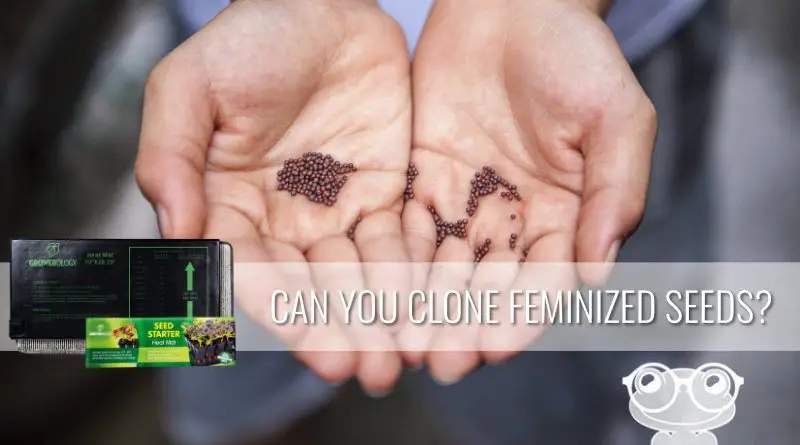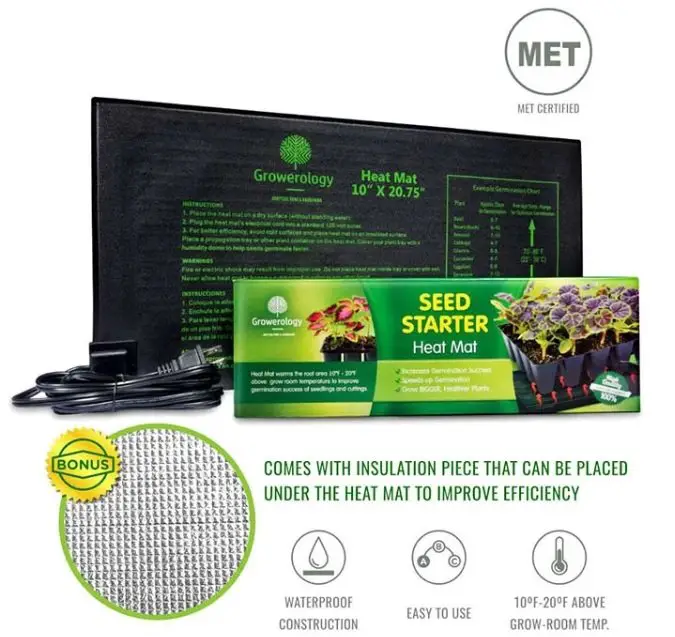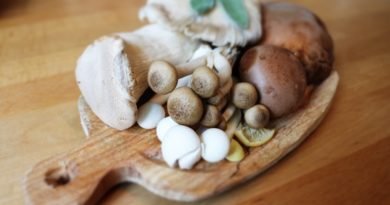Last modified on March 12th, 2020 at 3:30 am
Can You Clone Feminized Seeds? Gardening 101
Cloning feminized seeds is actually more of a common practice than you may think. Due to the many benefits that cloning offers, many people use this method to yield a healthy and effective crop. The Growerology Seeding Hat Mat will help you with the growing process if you are interested in trying it out for yourself. In this guide, we’ll also educate you about what feminized seeds are and how you can clone them correctly.
PRODUCT REVIEW
The 2 pack Growerology Seedling Heat Mat is designed to help your plants grow faster and bigger by providing them with a source of warmth that promotes healthy growth. The insulation mat that comes included with the heat mat works to improve the overall effectiveness by helping direct the heat to the plant without losing any essential sources of heat. You will surely benefit from the advantages that the Growerology Seedling Heat Mat has to offer:
- Offers multiple uses, such as growing plants, forming reptile terrariums, and brewing kombucha.
- The durability of this product ensures its effectiveness to remain strong through any use
- The insulation piece offers extra benefits to the growth of your plants
- Offers faster plant growth to help your plants grow bigger and stronger than they normally would
- Built with waterproof construction

Seedling Heat Mat
2 Pack (10"x 20.75")
Perfect for your Seed Germination needs
What a Feminized Seed is
Feminized seeds are seeds that produce exclusively female plants. One of the most prominent reasons for using it is that they can produce cannabis seeds. Female cannabis plants are the only type that are capable of producing buds, so having a female-only crop of cannabis plants will guarantee that every plant will sprout a flower. Cloning Cannabis seeds have the same characteristics and picking the right strains is an undeniable process to cloning marijuana seeds. It ensure a high probability of having a successful cloning. To know more about the picking process, try this article from Weekend Gardener.
It is not an easy task to try and differentiate the male plants from the female plants. Growing buds from female-only crops can eliminate the guesswork and save space in your garden to grow more female plants. It is also more cost efficient since you are not wasting money by throwing away the male plants. It will also eliminate the possible risk of unwanted pollination from male plants that may cause problems for the entire rest of the crop and their growing efficiency.
There are two different ways in which you can feminize seeds. You can either give your plants a chemical substance that will make the female plants pollinate or you can produce them naturally. The natural way, however, may cause a few issues in your plant growth. The female plant will grow stressed and become a hermaphrodite so it will be able to self-pollinate. This can harm the breeding and growing process for other plants and any seeds that they produce, so it is best to avoid the natural process.
Another popular method of producing female seeds is through seed cloning. To clone feminized seeds, take a sample from the plant that you want to clone. Place it in an environment where it can grow effectively. Provide it with the nutrients it needs to grow. While there are limitations to this method of plant growing, there are still many benefits that you can reap with the cloned plants you grow.
How to Clone Feminized Seeds

Step One: Selecting the Original Plant
It takes a lot of work in order to clone seeds, and one of the most important steps will start with choosing a mother plant to clone. Observe the growth patterns and health of each one of your pre-existing plants. Determine which one will be a good candidate for cloning and laying the foundation for the cloned seed. Choosing a plant with the best quality will yield positive results for your cloned plant. You must make sure that you are working within a sterile environment and that none of your plants have been fertilized for a few days prior to the beginning of the cloning process.
Step Two: Cutting the Stem of the Plant
Cut as close as you can to the main stem at a 45 degree angle without damaging the roots. After you have your sample, place it in the water in order to prevent air bubbles from appearing within it. Remove any excess leaves from your sample.
Step Three: Technique
The next step is to choose the cloning method you will use. Three commonly popular methods are the Water Method, the Rockwoll Method, and the Potting Soil Method, and each one comes with their own benefits and disadvantages. No matter what method you choose, make sure that it will bring out the best benefits for the plant you are cloning and that it has the best chance of survival.
Step Four: Transplanting
The clones will be able to develop effectively in its new environment. After the clones have had ample time to grow, transplant them into the contained area you want them to grow in. Allow the plant to develop on its own from that point on.
Taking Care of the Clones
Your plant will still require a bit of tender loving care after it has been transplanted. The cloned plants will have to be handled differently from the normal plants. This is because they have gone through a different growing process than the mother plant did. For example, you may want to place the growing lights a bit farther away from the cloned plants depending on the strength of the lights. The cloned plants will be a bit more sensitive to the lighting conditions than the mother plants, and may wilt or become dehydrated as a result.
Conclusion
Planting, growing, and cloning feminized seeds will take a lot of time, patience, and a high level of maintenance. If you want to yield the best results, take the time to make sure your plants grow properly. Ensure that you follow the precise method of cloning for whichever technique you decide to use. If you find yourself having any trouble, the Growerology Seeding Heat Mat can help promote healthy plants and help with the overall growing process.






